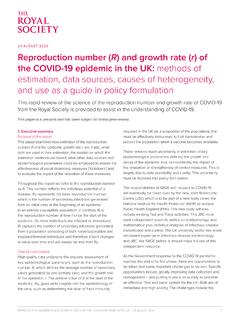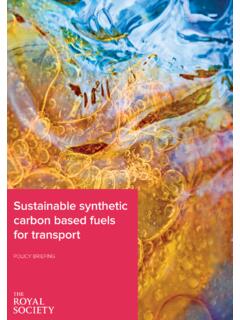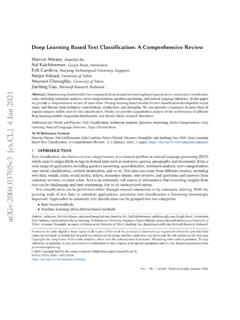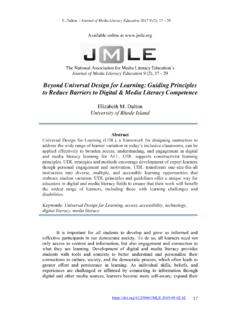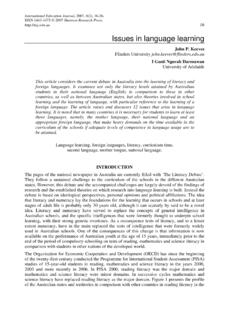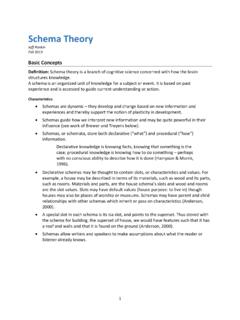Transcription of Neuroscience: implications for education and lifelong learning
1 brain Waves Module 2:Neuroscience: implications for education and lifelong learningFebruary 2011 For further informationThe Royal SocietyScience Policy Centre6 9 Carlton House TerraceLondon SW1Y 5 AGT +44 (0)20 7451 2550F +44 (0)20 7451 2692E Royal SocietyThe Royal Society is a Fellowship of more than 1400 outstanding individuals from all areas of science, mathematics, engineering and medicine, who form a global scientifi c network of the highest calibre. The Fellowship is supported by over 140 permanent staff with responsibility for the day-to-day management of the Society and its activities. The Society encourages public debate on key issues involving science, engineering and medicine, and the use of high quality scientifi c advice in policy-making. We are committed to delivering the best independent expert advice, drawing upon the experience of the Society s Fellows and Foreign Members, the wider scientifi c community and relevant are working to achieve fi ve strategic priorities:Invest in future scientifi c leaders and in innovationInfl uence policymaking with the best scientifi c adviceInvigorate science and mathematics educationIncrease access to the best science internationallyInspire an interest in the joy, wonder and excitement of scientifi c discoveryPrice 20 ISBN: 978-0-85403-880-0 Issued: February 2011 Report 02/11 DES2105 Founded in 1660, the Royal Societyis the independent scientific academyof the UK, dedicated to promotingexcellence in scienceRegistered Charity No 2070430388007808549 ISBN 978-0-85403-880-0 Cover image.
2 A map composed of data submitted to OpenStreetMap of people walking, driving and cycling around central London. The thicker the lines, the more people travelled that route, an appropriate metaphor for the way our brains develop networks of connected neurons through learning . Professor Eleanor Maguire and colleagues at UCL have advanced our understanding of how the brain changes in response to learning in adulthood. Maguire and colleagues showed that licensed taxi drivers, who spend years acquiring the Knowledge of London s complex layout, have greater grey matter volume in a region of the brain known to be essential for memory and navigation. (Woollett K, Spiers HJ, & Maguire EA (2009). Talent in the taxi: a model system for exploring expertise. Phil Trans R Soc B 364(1522), 1407 1416.) Map OpenStreetMap contributors, CC-BY-SABrain Waves Module 2: Neuroscience: implications for education and lifelong learningRS Policy document 02/11 Issued: February 2011 DES2105 ISBN: 978-0-85403-880-0 The Royal Society, 2011 Requests to reproduce all or part of this document should be submitted to:The Royal SocietyScience Policy Centre6 9 Carlton House TerraceLondon SW1Y 5 AGTel +44 (0)20 7451 2550 Email Waves Module 2: Neuroscience.
3 implications for education and lifelong learningContentsSummary vWorking Group Membership vii1 Introduction 12 Insights and opportunities Both nature and nurture affect the learning brain The brain is plastic The brain s response to reward is infl uenced by expectations and uncertainty The brain has mechanisms for self-regulation education is a powerful form of cognitive enhancement There are individual differences in learning ability with a basis in the brain Neuroscience informs adaptive learning technology 143 Challenges The charges of reductionism and determinism The inappropriate exploitation of neuroscience Building a common language 18 brain Waves 2 I February 2011 I iiiThe Royal Society4 Recommendations Strengthening the science base for education Informing teacher training and continued professional development Informing adaptive technologies for learning and cognitive training Building bridges and increasing knowledge of neuroscience 20iv I February 2011 I brain Waves 2 The Royal SocietySummaryEducation is about enhancing learning , and neuroscience is about understanding the mental processes involved in learning .
4 This common ground suggests a future in which educational practice can be transformed by science, just as medical practice was transformed by science about a century ago. In this report we consider some of the key insights from neuroscience that could eventually lead to such a research suggests that learning outcomes are not solely determined by the environment. Biological factors play an important role in accounting for differences in learning ability between considering biological factors, research has advanced the understanding of specifi c learning diffi culties, such as dyslexia and dyscalculia. Likewise, neuroscience is uncovering why certain types of learning are more rewarding than brain changes constantly as a result of learning , and remains plastic throughout life. Neuroscience has shown that learning a skill changes the brain and that these changes revert when practice of the skill ceases.
5 Hence use it or lose it is an important principle for lifelong , our adaptive response to stress and adversity, can be built up through education with lifelong effects into old acquisition of knowledge and mastery of self-control benefi t future learning . Thus, neuroscience has a key role in investigating means of boosting brain ome insights from neuroscience are relevant for the development and use of adaptive digital technologies. These technologies have the potential to create more learning opportunities inside and outside the classroom, and throughout life. This is exciting given the knock-on effects this could have on wellbeing, health, employment and the is great public interest in neuroscience, yet accessible high quality information is scarce. We urge caution in the rush to apply so-called brain -based methods, many of which do not yet have a sound basis in science.
6 There are inspiring developments in basic science although practical applications are still some way emerging fi eld of educational neuroscience presents opportunities as well as challenges for education . It provides means to develop a common language and bridge the gulf between educators, psychologists and Waves 2 I February 2011 I vThe Royal Societyvi I February 2011 I brain Waves 2 The Royal SocietyWorking Group MembershipThe members of the Working Group involved in producing this report were as follows:ChairProfessor Uta Frith FRS FBA FMedSciEmeritus Professor, Institute of Cognitive Neuroscience, University College London and Visiting Professor at Aarhus University, Aarhus, DenmarkMembersProfessor Dorothy BishopFBA FMedSciProfessor of Developmental Neuropsychology, University of OxfordProfessor Colin BlakemoreFRS FMedSciProfessor of Neuroscience, University of OxfordProfessor Sarah-Jayne BlakemoreRoyal Society University Research Fellow and Professor of Cognitive Neuroscience, University College LondonProfessor Brian ButterworthFBAP rofessor of Cognitive Neuropsychology, University College LondonProfessor Usha GoswamiProfessor of Cognitive Developmental Neuroscience and Director, Centre for Neuroscience in education , University of CambridgeDr Paul Howard-JonesSenior Lecturer in education at the Graduate School of education .
7 University of BristolProfessor Diana LaurillardProfessor of learning with Digital Technologies, Institute of EducationProfessor Eleanor MaguireProfessor of Cognitive Neuroscience at the Wellcome Trust Centre for Neuroimaging, Institute of Neurology, University College LondonProfessor Barbara J SahakianFMedSciProfessor of Clinical Neuropsychology, Department of Psychiatry and the MRC/Wellcome Trust Behavioural and Clinical Neuroscience Institute, University of Cambridge School of Clinical MedicineAnnette SmithFInstPChief Executive, Association for Science EducationBrain Waves 2 I February 2011 I viiThe Royal SocietyRoyal Society Science Policy Centre TeamDr Nick GreenHead of ProjectsIan ThorntonPolicy AdviserDr Rochana Wickramasinghe Policy AdviserRapela ZamanSenior Policy AdviserTessa Gardner, Jessal Patel, Chris YoungSPC InternsThis report has been reviewed by an independent panel of experts and also approved by the Council of the Royal Society.
8 The Royal Society gratefully acknowledges the contribution of the reviewers. The review panel were not asked to endorse the conclusions or recommendations of the report, nor did they see the fi nal draft of the report before its PanelDame Jean Thomas DBE FRS FMedSci (Chair)Biological Secretary and Vice President, the Royal SocietyProfessor Tim Bliss FRS FMedSciDivision of Neurophysiology, National Institute for Medical ResearchProfessor Barry Everitt FRS FMedSciDepartment of Experimental Psychology, University of CambridgeProfessor Karl Friston FRS FMedSciScientifi c Director, Wellcome Trust Centre for Neuroimaging, University College LondonDame Nancy Rothwell DBE FRS FMedSciPresident and Vice Chancellor, University of ManchesterProfessor Elsbeth SternProfessor for learning and Instruction, ETH Zurichviii I February 2011 I brain Waves 2 The Royal SocietyWe would like to thank all those consulted during the course of this study, including the eminent neuroscientists and policy offi cials who helped during the scoping of the work as well as those who attended the Royal Society s stakeholder discussion education .
9 What s the brain got to do with it? held in partnership with the Wellcome Trust. See Appendices 1 and 2 for Waves 2 I February 2011 I ixThe Royal Societyx I February 2011 I brain Waves 2 The Royal SocietyEducation is the wellspring of our health, wealth and happiness. It allows human beings to transcend the physical limits of biological evolution. We know that education works through experiences that are dependent on processes in the brain , and yet we still understand far too little about these processes. Neuroscience studies have begun to shed light on the mental processes involved in learning . In this report we explore the extent to which these new scientifi c insights can inform our approach to rapid progress in research in neuroscience is producing new insights that have the potential to help us understand teaching and learning in new ways. education is far more than learning facts and skills such as reading.
10 It is not confi ned to the school years, but plays an important role throughout the lifespan and helps individuals cope with adversity. Flexibility through learning enables people of any age to adapt to challenges of economic upheaval, ill health, and ageing. The new fi eld of educational neuroscience , sometimes called neuroeducation , investigates some of the basic processes involved in learning to become literate and numerate; but beyond this it also explores learning to learn , cognitive control and fl exibility, motivation as well as social and emotional experience. With the effective engagement of all learners as well as teachers, parents and policy makers, the impact of this emerging discipline could be highly benefi affects the wellbeing of individuals and has economic benefi The economic and social cost of an education system that does not facilitate learning for all and learning throughout life is ,3,4 There is accumulating scientifi c knowledge that could benefi t all groups of learners: children, young people, adults and older people.


